CeoTronics CT-RXRCDM14 CT-ClipCom digital User Manual dok1363 be
CeoTronics AG CT-ClipCom digital dok1363 be
User Manual
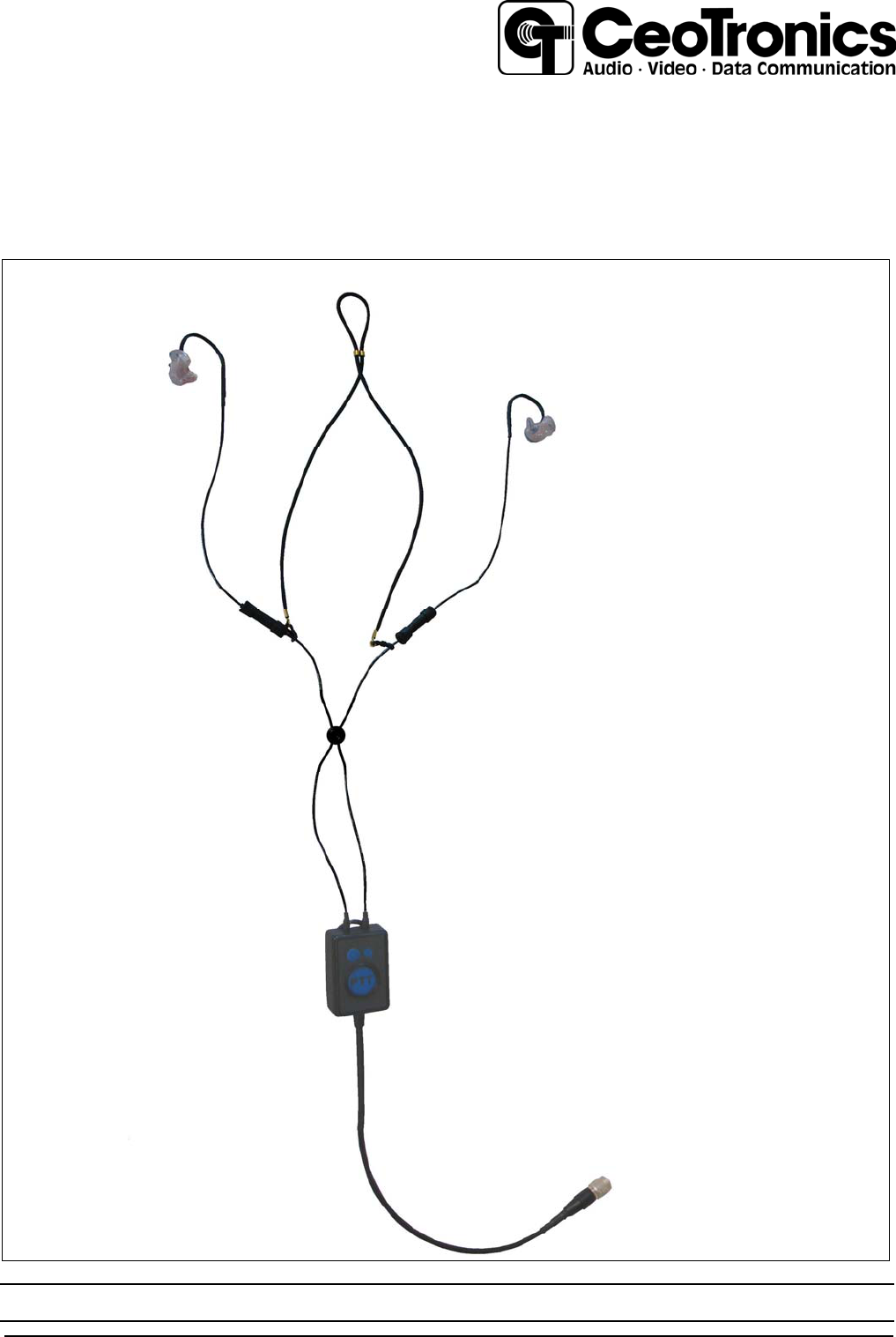
CT-ClipCom Digital
Operating Instructions
Example
English

2
Contents
1. Important safety instructions .............................................................................................................. 2
2. Description ......................................................................................................................................... 3
2.1 Ear-microphone ............................................................................................................................... 5
2.2 Earphone with gooseneck-microphone ........................................................................................... 5
2.3 Individually ear mould ...................................................................................................................... 6
2.4 Wired PTT-button ............................................................................................................................ 7
2.5 CT-Wireless-PTT (option) ................................................................................................................ 8
3. Commissioning and operation ........................................................................................................... 9
4. Safekeeping – storage ..................................................................................................................... 10
5. Maintenance .................................................................................................................................... 10
5.1 Visual inspections ..................................................................................................................... 10
5.2 Cleaning .................................................................................................................................... 10
5.3 Changing the protective cover of the gooseneck microphone .................................................. 11
5.4 Changing the battery of the optional CT-Wireless-PTT ............................................................ 11
6. Consumable parts ............................................................................................................................ 12
1. Important safety instructions
For the use of the device notice the national safety and accident prevention
regulations and the following safety instructions shown in italics in this instruction
manual.
z Before using CeoTronics products read completely the appropriate operating instructions. If in doubt,
ask our technical staff.
z Use only CeoTronics products without damage and wear.
z If repair work of any kind needs to be done to CeoTronics products, arrange for it to be performed
only by the company CeoTronics or by a specialized workshop that is authorized by CeoTronics. In
all other cases our warranty and liability for the product shall lapse.
z Do not store CeoTronics products outside or in damp ambient conditions. At all times keep them
clean, dry and at normal air humidity. CeoTronics products must not be stored in areas with a
temperature of over +80° C (+176° F), e.g. in the summertime on the parcel shelf of a car. If not
stated otherwise, the following temperature ranges are allowed for CeoTronics products: -10 to
+55° C (+14 to +131° F) for operation, -40 to +80° C (-40 to +176° F) for storage.
z Do not immerse a CeoTronics product into water, if it is not expressly specified for this purpose.
z When using CeoTronics products that are equipped with connection leads ensure that the latter do
not get caught up in operational machinery or wheels!
z CeoTronics products that are not intrinsically safe (explosion-proof) and therefore have no special
explosion-proof designation must never be operated in potentially explosive environments (e.g.
when refuelling cars, aircraft etc.). Devices that are not explosion-proof can unintentionally trigger off
explosions in such areas!
z Connect CeoTronics accessories to a device or disconnect them from a device only when the device
is switched off.
z After switching on the communication system, set the reception volume to approx. 1/2 the available
loudness volume and then test the audible volume, e.g. by opening the squelch on the radio set.
Do not set the volume any higher than is necessary. A very high volume setting can lead to
damaged hearing, particularly if it is continuous. For high volumes or noise levels wear additional ear
plugs. If in doubt, ask your safety officer or company doctor.

3
z Do not leave CeoTronics products lying around loose in cars, e.g. on the parcel shelf. Stow these
products in a suitable, safe place in the car so that they do not present a danger to you or to other
occupants of the car, if emergency braking is effected.
z Keep CeoTronics products out of the reach of children and any other persons who are not familiar
with the handling and operation thereof.
z Packaging materials, e.g. filling materials and plastic bags are not toys and have to be kept out of
the reach of children. There is a risk of children ingesting them and choking!
z Safe operation requires clean devices. Ensure that the devices (microphones, connectors etc.) are
clean and in good condition at all times.
z CeoTronics products may only be used for the specific application envisaged.
z Should equipment, supplied by CeoTronics, be definitely put out of service you may return it to
CeoTronics. We ensure recycling and/or disposal of outdated equipment in compliance with
the applicable environment protection law.
z Keep these operating instructions for later use.
2. Description
General
The CT-ClipCom Digital is a binaural communication system for use with radio equipment. The PTT
buttons (PTT=push-to-talk) of the system are used to transmit PTT commands to the radio unit or
similar communication systems.
The following two system configurations are available:
CT-ClipCom Digital ear microphone consisting of one ear microphones plus one earphone, a PTT
transmit button, and an optional CT-Wireless-PTT
CT-ClipCom Digital gooseneck microphone consisting of one earphone plus one earphone with
gooseneck microphone, a PTT transmit button, and an optional CT-Wireless-PTT
The earphones/ear microphones are electro-acoustic transducers, used either as microphones (for
transmitting) or earphones (for receiving), worn in the ear with individually formed ear moulds.
The system is optionally equipped with ambient sound reception (ASR) for both sides.
Power is normally provided by the radio unit.
The components of the CT-ClipCom Digital are supplied either firmly connected or with plug-type
connectors.
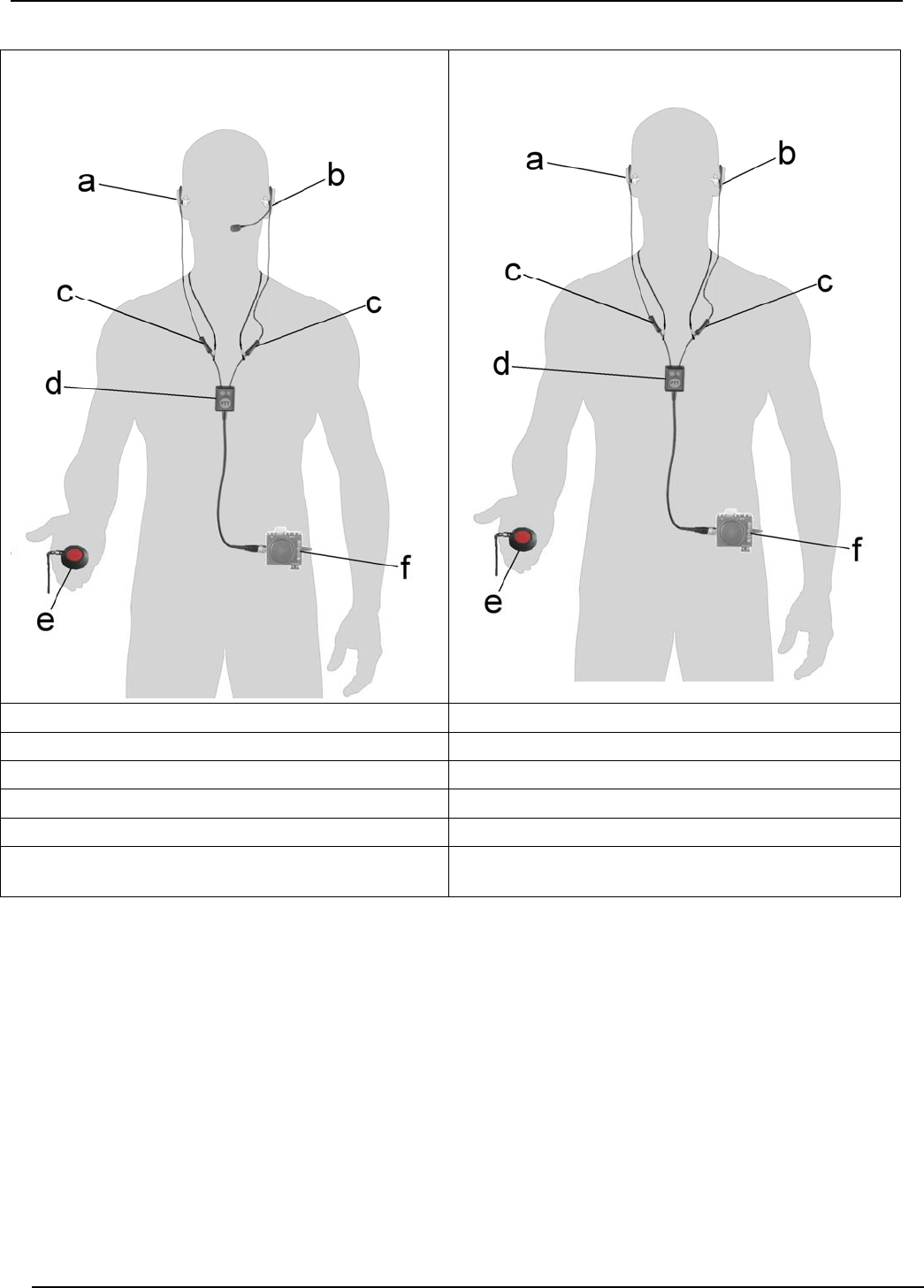
4
System overview (examples)
figure 1 CT-ClipCom Digital gooseneck
microphone
figure 2 CT-ClipCom Digital ear-microphone
a ear-phone a ear-microphone
b earphone with gooseneck microphone b ear-phone
c connector c connector
d PTT-button d PTT-button
e CT-Wireless-PTT (Option) e CT-Wireless-PTT (Option)
f accessories or two-way radio (example, not
in scope of delivery)
f accessories or two-way radio (example, not
in scope of delivery)
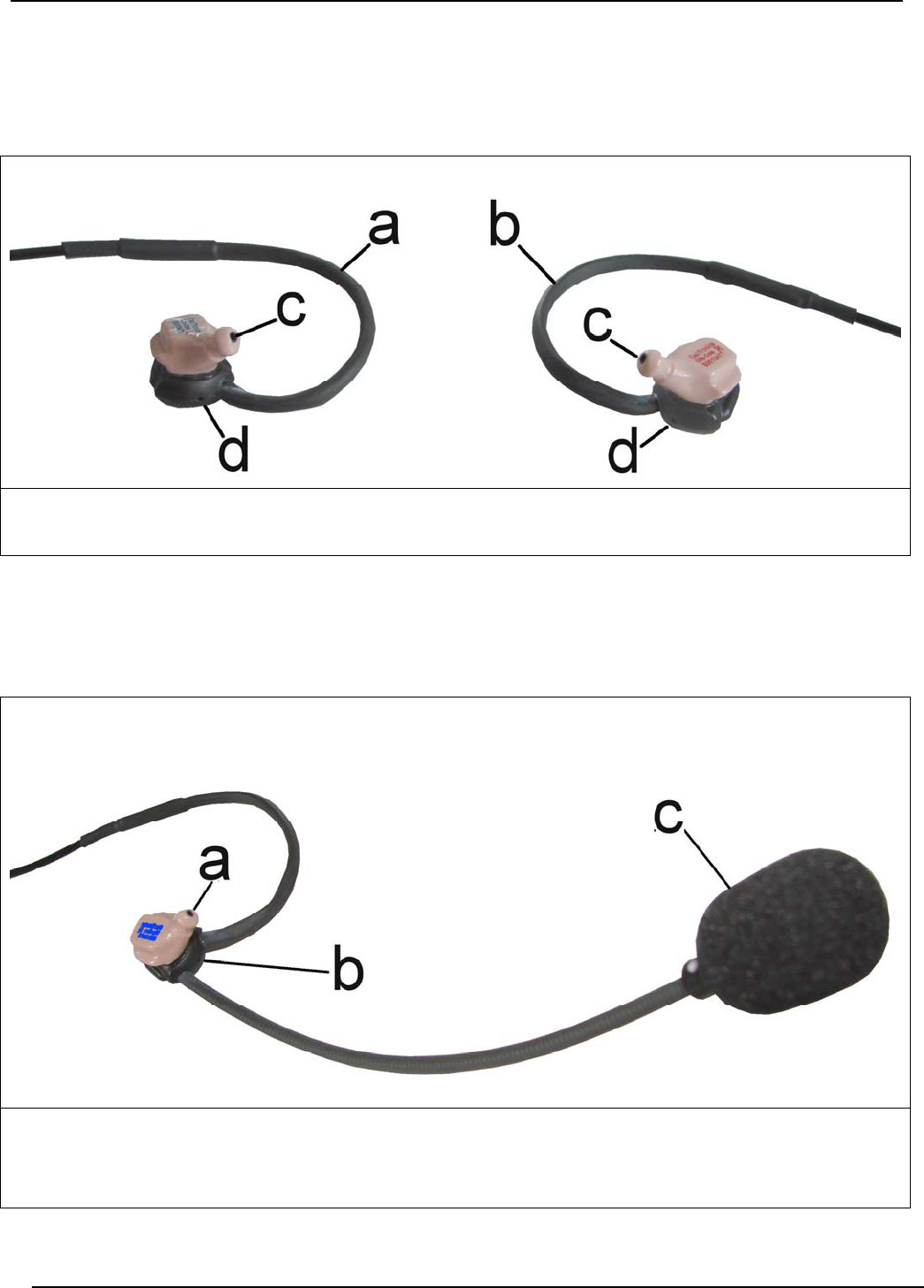
5
2.1 Ear-microphone
The ear-microphone is at the right side and is identified by a red marking. The earphone is at the left
side and is identified by a blue marking. The casing of the ear-microphone contains the optional ASR-
microphone (figure 3/d) in addition to the ear-microphone itself (figure 3/c). For using the ear-
microphone it is just clipped onto the individual ear mould (see 2.3).
figure 3
a ear-phone left b ear-microphone right
c ear-microphone and earphone d ASR-microphone (Option)
2.2 Earphone with gooseneck-microphone
The earphone with gooseneck microphone is available for the left ear only. Gooseneck microphone with
protective cover (figure 4/c) and optional ASR-microphone (figure 4/b) are attached to the earphone.
For using the earphone it is clipped onto an individual ear mould.
figure 4
a earphone
b ASR-microphone (Option)
c gooseneck-microphone with windshield
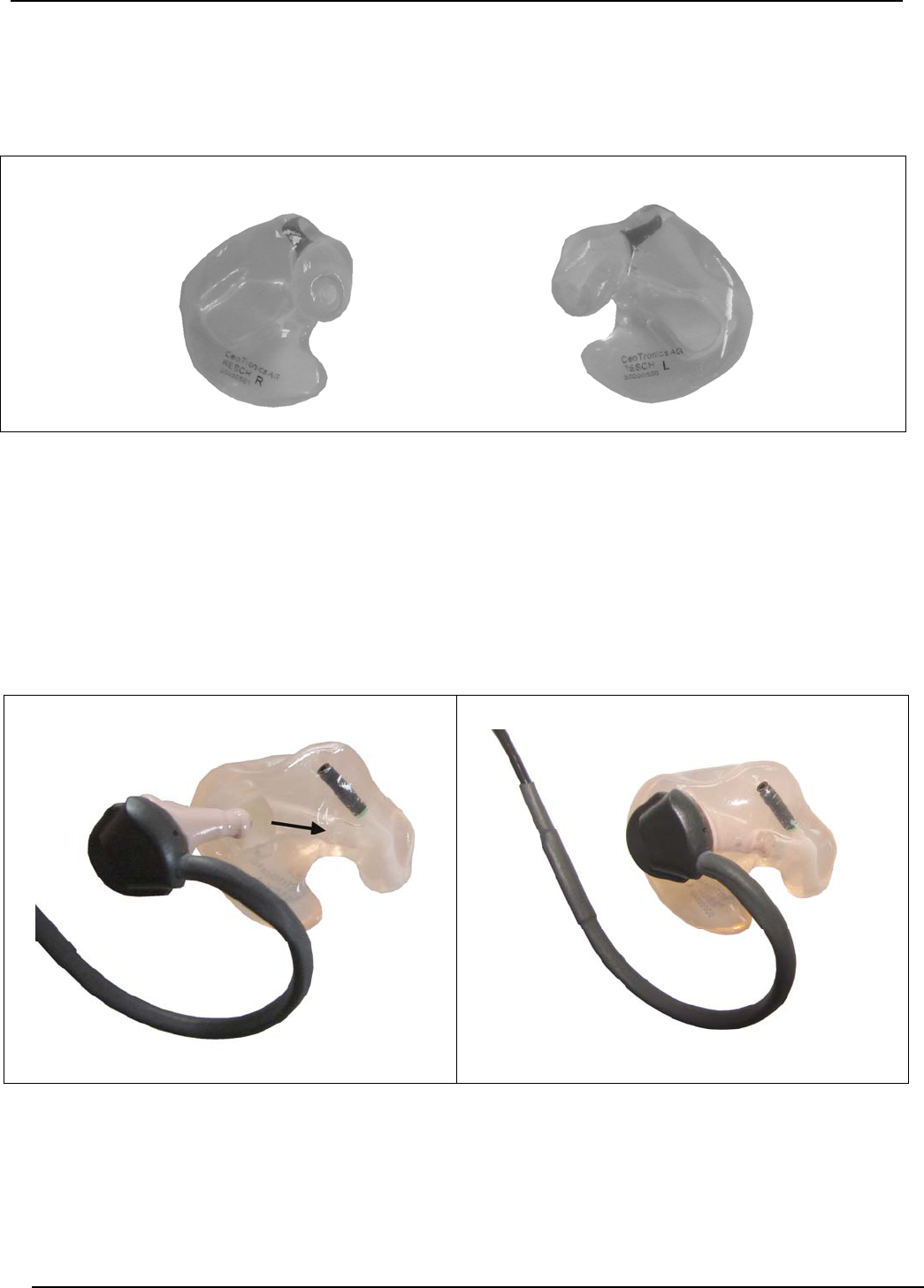
6
2.3 Individually ear mould
This ear mould (example Fig. 5) ensures maximum wear comfort and transmission quality. It is moulded
according to an individual impression of the auditory canal either for wearing in the right ear or in the left
ear. For different personal needs different variants are available. The earphone is “clipped” in the ear
mould. The ear mould is worn in the ear.
figure 5 right ear mould left ear mould
Installing the ear microphone in the ear mould
Î PLEASE NOTE
Earphone and ear mould for the right ear have a red ink marking, the ear microphone and ear
mould for the left ear are marked with blue ink.
a. Take the ear mould in one and the ear microphone in the other hand. The sound channels of ear
mould and ear microphone must be looking into the same direction (figure 6).
b. Push the ear microphone in direction of the arrow into the ear mould until it “engages”.
Figure 7 shows the ear microphone inserted in the ear mould.
figure 6
figure 7
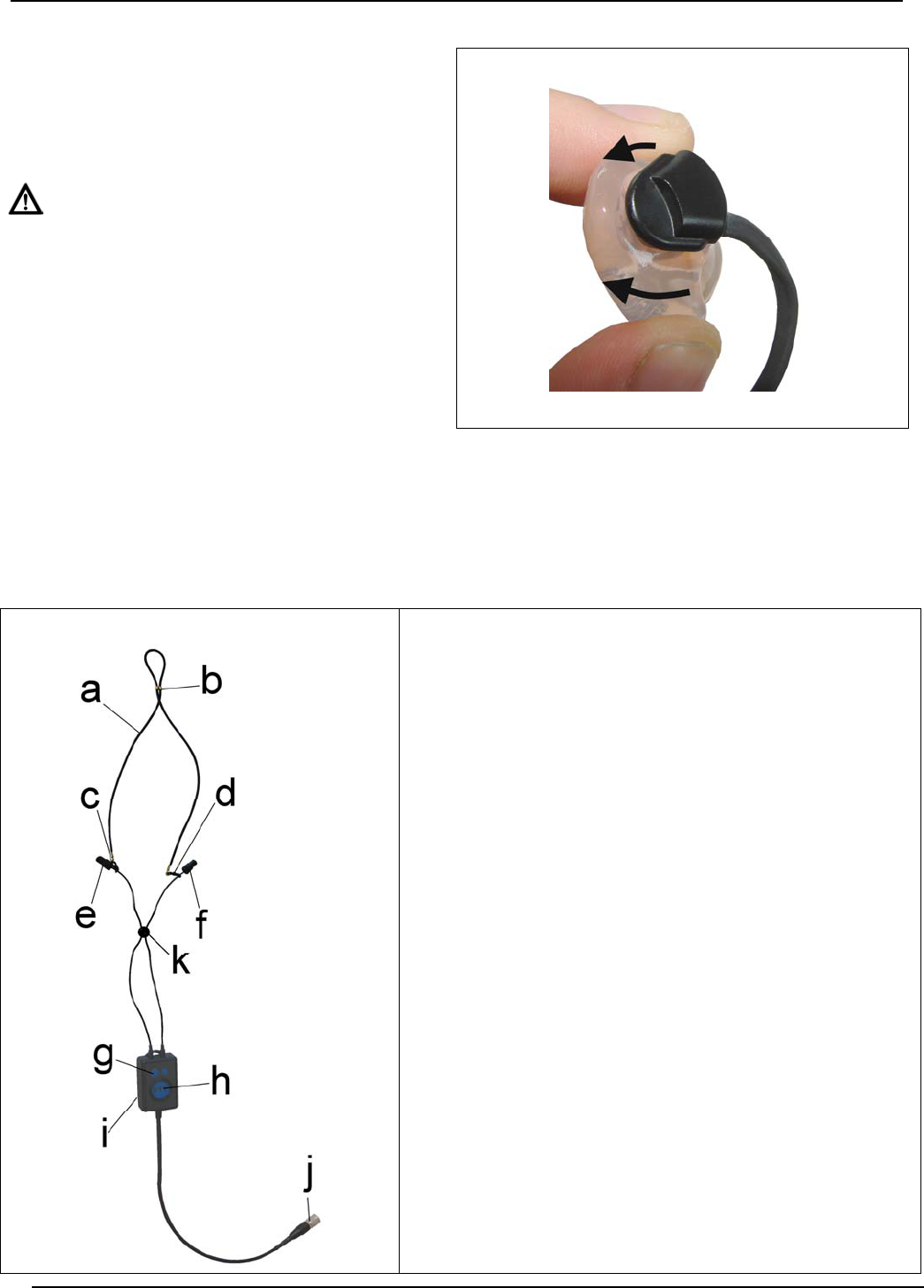
7
Removing the earphone from the ear mould
a. Take the ear mould in one hand and press the
two ends of it against each other (figure 8)
until ear microphone "disengages" from the
ear mould.
ATTENTION!
Never extract the earphone from the ear mould
by pulling the cable.
b. Now hold the earphone with the other hand
and pull it out of the ear mould.
figure 8
2.4 Wired PTT-button
The PTT transmit button is provided with connecting cable and plug for connection to a radio unit
adaptor. The PTT transmit button and the optional CT-Wireless-PTT have equality of function. The
optional CT-Wireless-PTT must be subscribed to the wire-bound transmit button. Earphones/ear
microphones are available either with firm connection to the PTT transmit button or with plug-type
connectors.
figure 9 (example)
a Necklace
b Loop for adjusting the neck size
c Holding loop
d Holding loop
e Plug for connecting the RH CT-ClipCom earphone/ear
microphone (optional)
f Plug for connecting the LH CT-ClipCom earphone/ear
microphone (optional)
g Volume control for the ASR-microphone (option)
h PTT transmit button
i rear Fastening clip
j 12-pin plug for connection to a communication device
k cord stopper (option)
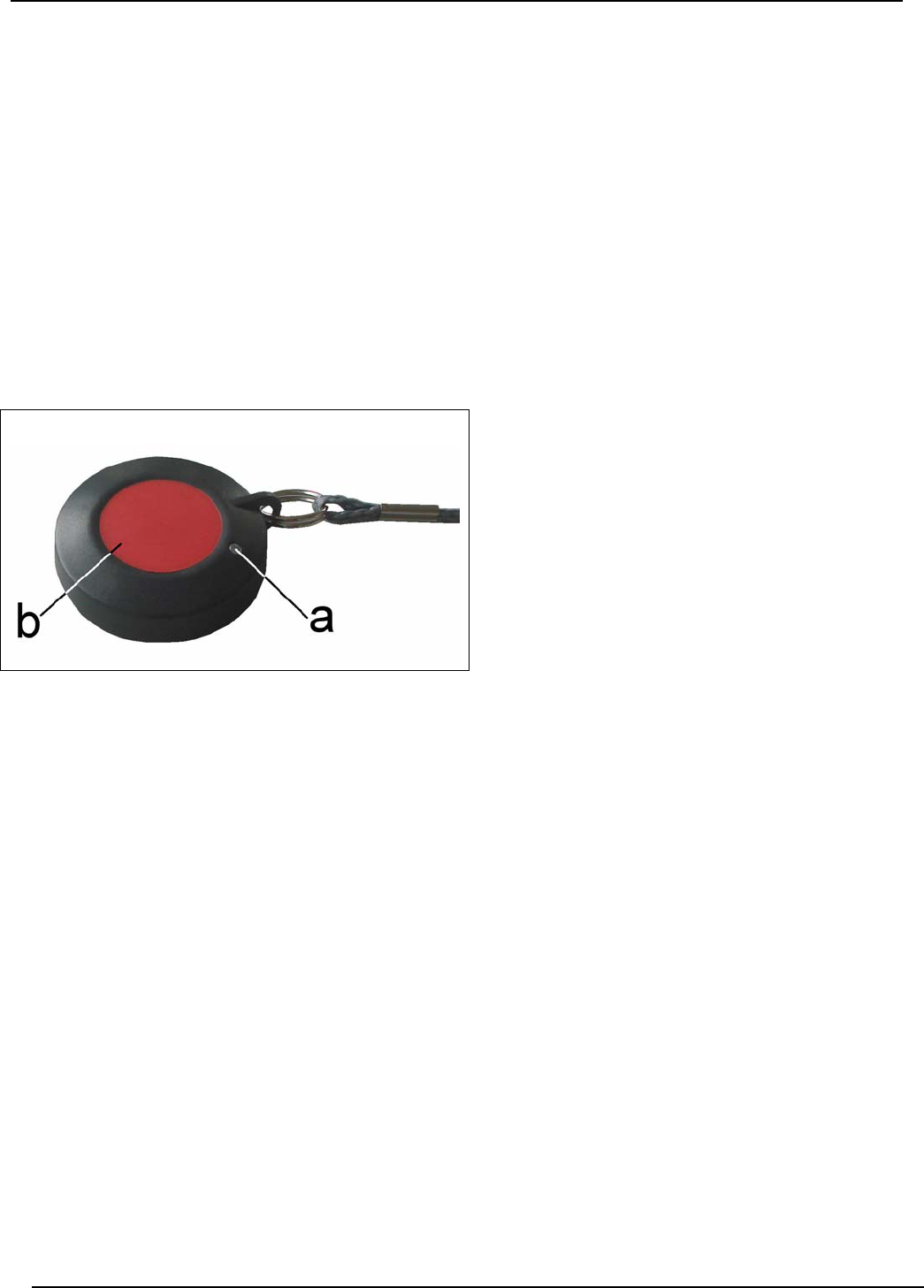
8
2.4.1 Ambient sound reception (option)
The ambient sound reception (ASR) happens via the microphones in the ClipCom earphones.
He can be adjusted with the key fig. 9/g of the appropriate situation.
The adjustment takes place in 4 steps
Initial position: 0dB (normal hearing)
1
st keying +6dB
2
nd keying OFF
3
rd keying -6dB
4
th keying RESET to 0dB
2.5 CT-Wireless-PTT (option)
This transmit button is a radio key to transmit PTT commands to a connected radio device. The CT-
Wireless-PTT and the wire-bound PTT transmit button (see chapter 2.4) have equality of function. The
CT-Wireless-PTT must be subscribed to the wire-bound transmit button. A battery provides power to
the CT-Wireless-PTT. For safety reasons, keying of the CT-Wireless-PTT is limited to 30 seconds.
figure 10
a LED – illuminates when the PTT button is
pressed
b PTT button
2.5.1 Subscription of the CT-Wireless-PTT to the wire-bound PTT transmit button
1. Switch OFF the radio unit connected to the wire-bound PTT transmit button if it is in switched-on
state
2. Insert the CT-ClipCom ear microphones/earphones in the ears
3. Press the two keys (figure 9/g, h) of the wire-bound PTT transmit button
– Keep the keys depressed and switch the radio ON
– Continue keeping the two keys depressed until you hear a short beep in the RH CT-ClipCom ear
microphone/earphone
– After it, let the two keys go
4. Press the PTT key (figure 9/h) of the wire-bound PTT transmit button 3 times
– After it you hear the following tone sequence – beep-beep-beep….beep-beep-beep…beep-
5. Now press the PTT key on the CT-Wireless-PTT until you hear a long tone lasting 4 seconds. Then
let the key go. Now you hear again the previous sequence of beeps.
6. Now, press the PTT key of the wire-bound PTT transmit button once. After it, you hear no more
beeps.
7. Then switch the communication system OFF.
Î PLEASE NOTE
As long as the wire-bound PTT transmit button is in programming mode, all other functions are
disabled. To exit the programming mode and enter into operating mode, the radio evice must be
switched OFF for at least 2 seconds and then switched ON again.
In case of loss of a CT-Wireless-PTT we recommend deleting it from the receiver.

9
2.5.2 Deleting one CT-Wireless-PTT from the memory of a wire-bound PTT
transmit button
1. Switch OFF the radio unit connected to the wire-bound PTT transmit button if it is in switched-on
state
2. Insert the CT-ClipCom ear microphones/earphones in the ears
3. Press the two keys (figure 9/d, e) of the wire-bound PTT transmit button
– Keep the keys depressed and switch the radio ON
– Continue keeping the two keys depressed until you hear a short beep in the RH CT-ClipCom ear
microphone/earphone
– After it, let the two keys go
4. Press the PTT key (figure 9/e) of the wire-bound PTT transmit button once and keep it depressed for
at least 1.6 seconds. The deletion mode is now activated.
– In deletion mode your hear a very fast tone sequence
– The deletion mode can be aborted by briefly pressing again the PTT key.
5. Now, press the PTT key for the CT-Wireless-PTT you want to delete and keep it depressed until you
hear a long tone lasting 4 seconds. The transmitter code is now deleted and you may release the
key.
2.5.3 Deleting all CT-Wireless-PTTs from the memory of a wire-bound PTT
transmit button
1. Switch OFF the radio unit connected to the wire-bound PTT transmit button if it is in switched-on
state
2. Insert the CT-ClipCom ear microphones/earphones into the ears
3. Press the two keys (figure 9/d, e) of the wire-bound PTT transmit button
– Keep the keys depressed and switch the radio ON
– Continue keeping the two keys depressed until you hear a short beep in the RH CT-ClipCom ear
microphone/earphone
– After it, let the two keys go
4. Press the PTT key (figure 9/e) of the wire-bound PTT transmit button once and keep it depressed for
at least 1.6 seconds. The deletion mode is now activated.
– In deletion mode your hear a very fast tone sequence
– The deletion mode can be aborted by briefly pressing again the PTT key.
5. Press now once more the PTT key of the wire-bound PTT transmit button for more than 1.6 seconds.
As soon as you hear a long tone lasting 4 seconds, all transmitter codes are deleted.
3. Commissioning and operation
a. Connect the ear microphones/earphones to the wire-bound PTT transmit button.
b. Place the necklace with the wire-bound PTT transmit button around your neck.
c. Inserting the ear microphone/earphone: Place the earhanger behind the ear. Insert the ear mould
into your ear with a quarter turn towards the back of the head until it has a snug fit. Adjust the seat of
the earhanger, if necessary.
d. Connect the wire-bound PTT transmit button with the connection plug to the radio or communication
device.
PLEASE NOTE
For connecting the PTT transmit button use only an adapter without keyload function. In case of
doubt, consult CeoTronics’ specialists.

10
Switch the radio or communication device ON and adjust at the radio or communication device the
desired volume of reception for the ear microphone.
CAUTION!
Before each start of operation control the volume of reception and adjust it, if necessary. Very
loud signals could damage your hearing.
Observe the manufacturer’s operating instruction for the radio and/or communication device.
e. Transmitting and receiving: For transmitting (speaking) press the wire-bound PTT transmit button or
the optional CT-Wireless-PTT and keep it depressed. For safety reasons, keying of the CT-Wireless-
PTT is limited to 30 seconds. The radio unit or communication device is switched to transmission.
You can speak as long as you keep the transmit button depressed. Let the transmit button go in
order to switch the radio unit or communication device back to standby/receiving (hearing).
CT-ClipCom Digital ear microphone
Radio messages and ringing tone of a cellular phone are heard on both sides. In case a PTT
transmit button is actuated or a communication is via a cellular phone, the ear microphone in the
right ear switches from earphone to microphone operation. Consequently, the ambient sound
reception (ASR) of this CT-ClipCom Digital is not active. The DNR electronics (Digital Noise
Reduction) filter and eliminate optional ambient noise from the voice signal.
CT-ClipCom Digital gooseneck microphone
During activation of the PTT transmit button, ambient sound reception is active on both sides. The
noise cancelling gooseneck microphone works without DNR function.
4. Safekeeping – storage
After use, keep the cleaned devices in a clean and dry place at normal room temperature and at normal
relative air humidity.
5. Maintenance
5.1 Visual inspections
Check the CT-ClipCom Digital and particularly the cables and connectors periodically for signs of
fractures, cracks and wear. Check ear moulds and earphones/ear microphones after every use for
pollution. Pollution can be the cause for skin irritation and malfunction.
5.2 Cleaning
ATENTION!
When cleaning, make sure that no moisture penetrates inside the device. Do not use any
solvents (e.g. benzine, alcohol, sterilizing agents, etc.). After cleaning, keep earphones/ear
microphones unpacked until completely dry.
Obstructed sound channels of ear moulds and ear plugs cause poor communication in transmitting
(speaking) and reception (hearing). For periodical cleaning of components we recommend special
cleaning tissues (see chapter 6).
Clean the contacts of connectors with a commonly available contact cleaning agent.
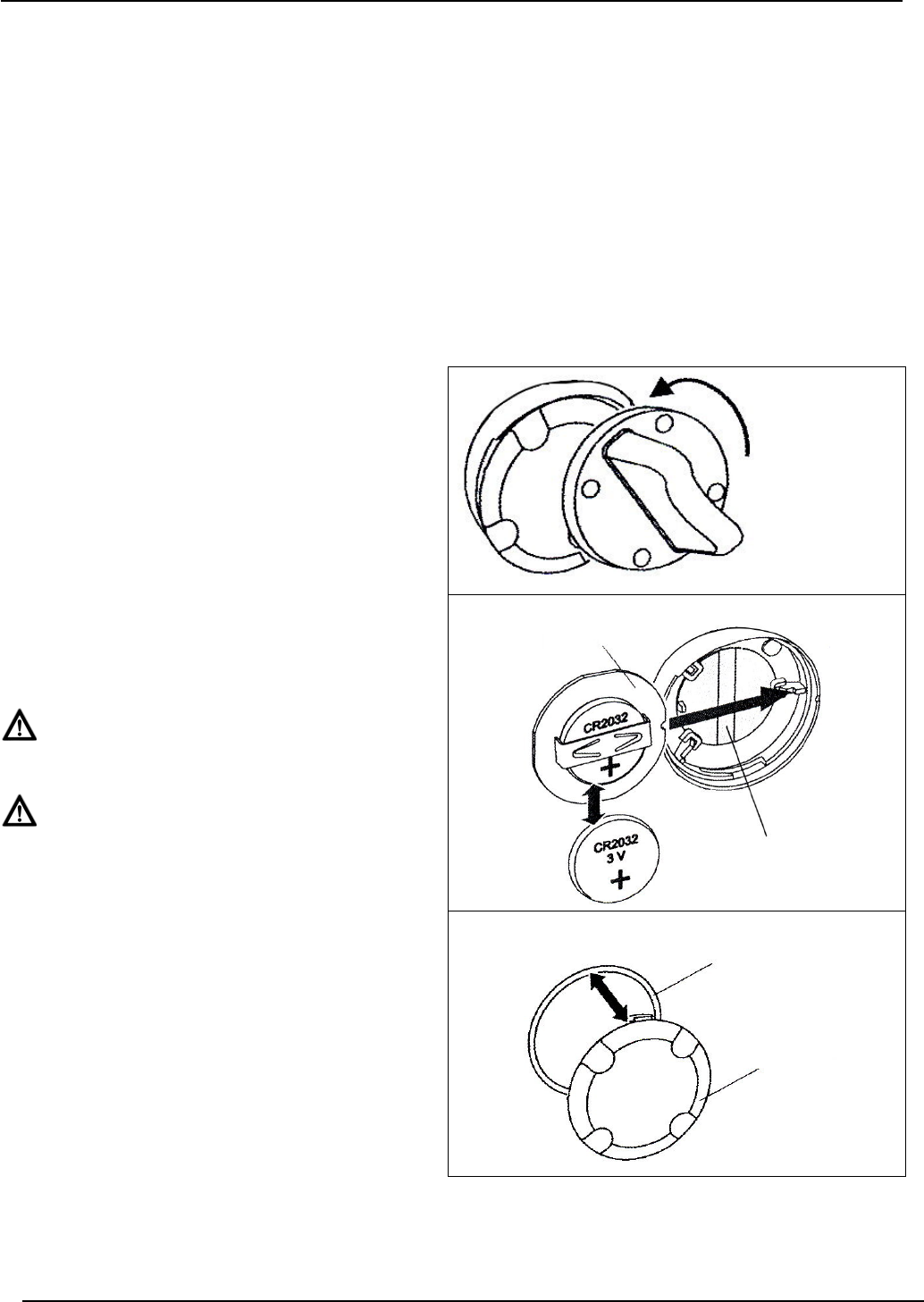
11
Ear moulds and Earphones
Obstructed sound channels of ear moulds and earphones cause poor reception. For regular cleaning
(after every use) we recommend the use of special antiseptic cleaning tissues (see item 6), an
appropriate cleaning spray, or soft clean cloths and pure water with some dishwashing liquid. Do not
use solvents for cleaning purposes.
For a basic cleaning of ear moulds we recommend a cleaning bath once a week (effervescent tablets;
e.g. Detax Smarttabs).
5.3 Changing the protective cover of the gooseneck microphone
Check the protective foam cover periodically for pollution, wear and deformation and replace it, if
necessary. It can be easily pulled off the microphone.
5.4 Changing the battery of the optional CT-Wireless-PTT
1. Open the battery compartment on the back of
the CT-Wireless-PTT using the opening tool
TKZ: 4008011 by a swift left turn.
2. Cautiously remove the circuit board from the
housing. Change the battery minding correct
polarity; lettering must be visible. Use 3-V
batteries type CR2032 only
ATENTION
Mind correct polarity!
ATENTION
Batteries may not be disposed off in the
domestic waste!
1
3. When closing the CT-Wireless-PTT put a new
sealing ring under the lid, if necessary.
Place the lid notches into the guides in the
housing and lock the lid with a right turn.
Make sure lid and housing have a tight fit.
2
circuit board
touch-lamina
sealing ring
lid
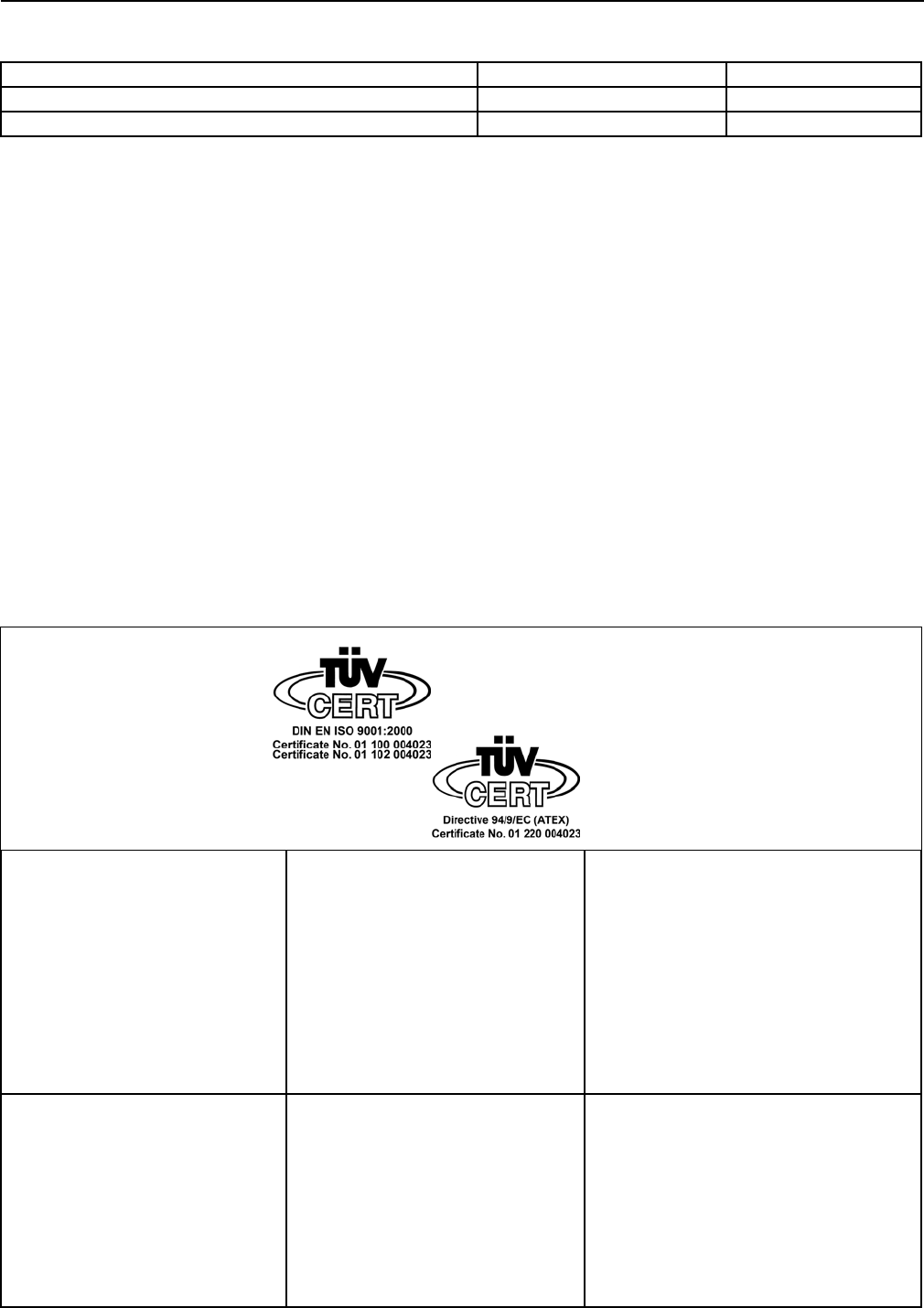
6. Consumable parts
Designation Unit Part No.
Cleaning tissues pack of 100 60 98 293
Protective microphone cover pack of 10 50 022 03
Germany and
International Sales
CeoTronics AG
Adam-Opel-Str. 6
63322 Rödermark
Tel. +49 6074 8751-0
Fax +49 6074 8751-676
E-Mail sales@ceotronics.com
USA/Canada/Mexico
CeoTronics, Inc.
300 Southport Circle, Suite 103
Virginia Beach, Virginia 23452
Tel. +1 757 549-6220
Fax +1 757 549-6240
E-Mail sales@ceotronicsusa.com
France
CeoTronics Sarl
Bât. Delta T
Z.A. du Tuboeuf
Allée des Pleus
77170 Brie Comte Robert
Tel. +33 1 60183300
Fax +33 1 60286060
E-Mail ventes@ceotronics.fr
Spain
CeoTronics S.L.
C/Ciudad de Frias 7 y 9
Nave 19
28021 Madrid
Tel. +34 91 4608250 51
Fax +34 91 4603193
E-Mail ventas@ceotronics.es
Switzerland
CeoTronics AG
Grundstr. 16
6343 Rotkreuz
Tel. +41 41 7905838
Fax +41 41 7905839
E-Mail info@ceotronics.ch
Poland
CeoTronics Sp. z o.o.
ul. Słonecza 15
91-491 Łódź (Polska)
Tel. +48 42 6553311
Fax +48 42 6552288
E-Mail biuro@ceotronics.pl
Germany and
International Sales
CT-Video GmbH
Gewerbegebiet Rothenschirmbach 9
06295 Lutherstadt Eisleben
Tel. +49 34776 6149-0
Fax +49 34776 6149-11
E-Mail ctv.info@ceotronics.com
Revision: 03/0710 y DOK 1363-be Änderungen vorbehalten
Copyright © 09/2009 CeoTronics AG, 63322 Rödermark, Deutschland, Internet www.ceotronics.com